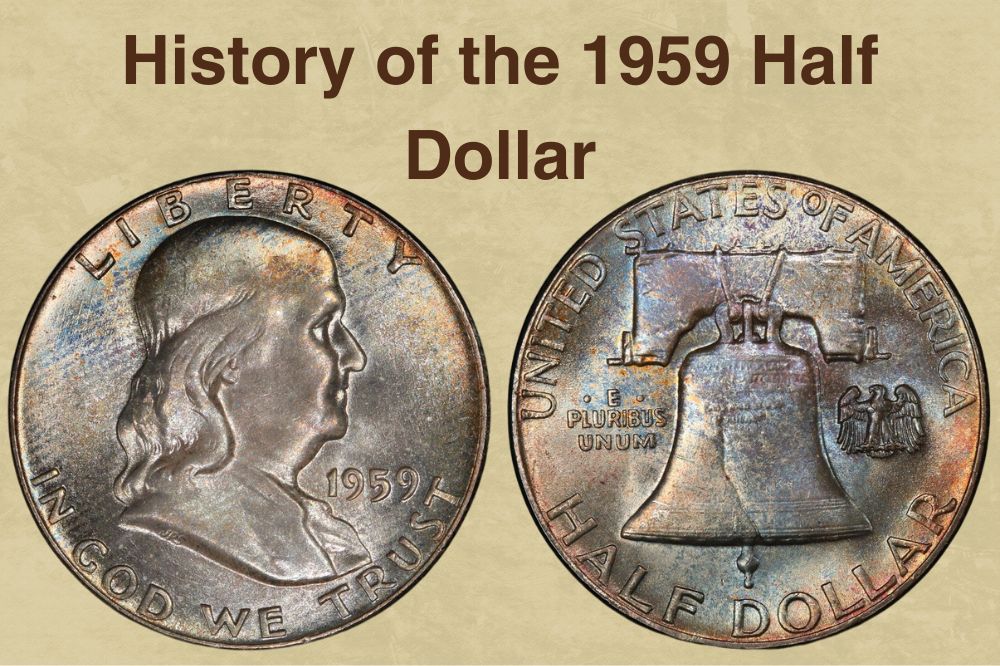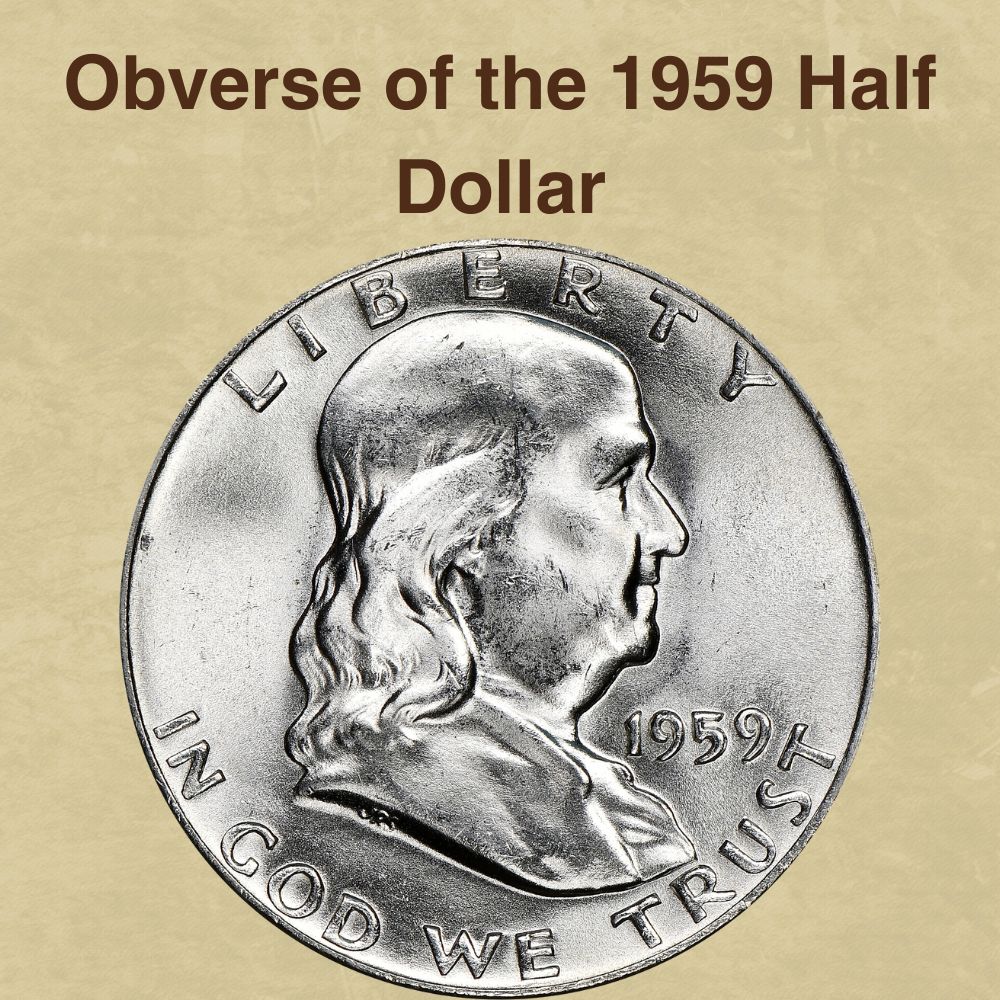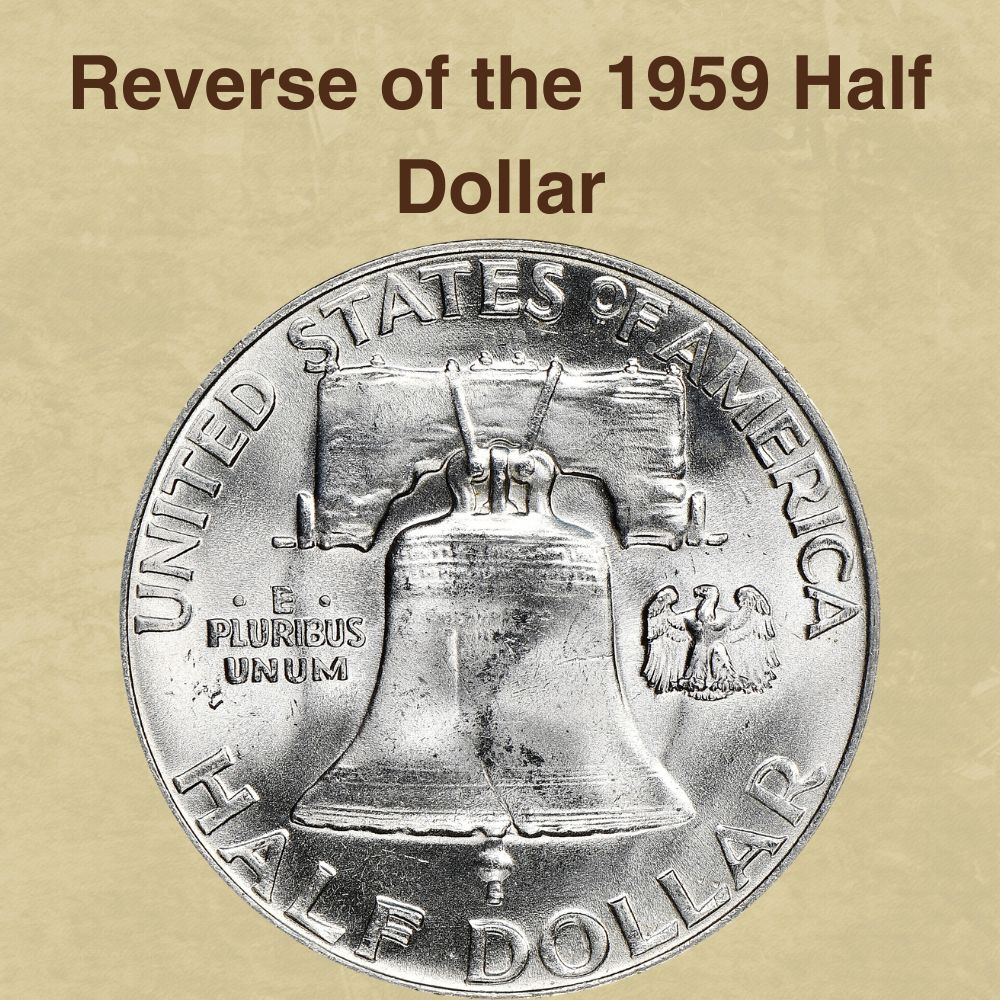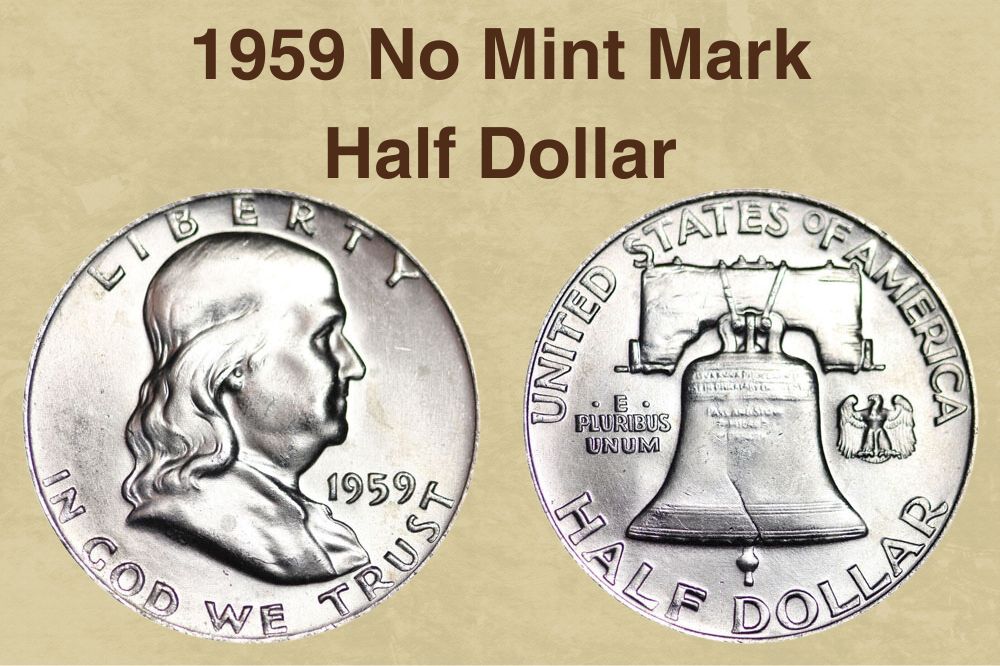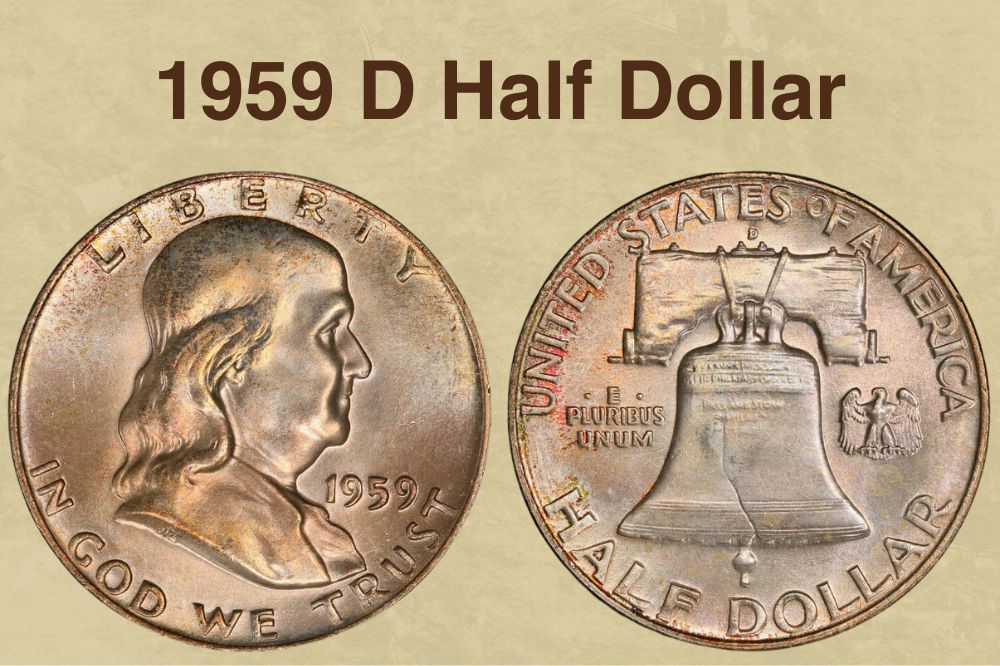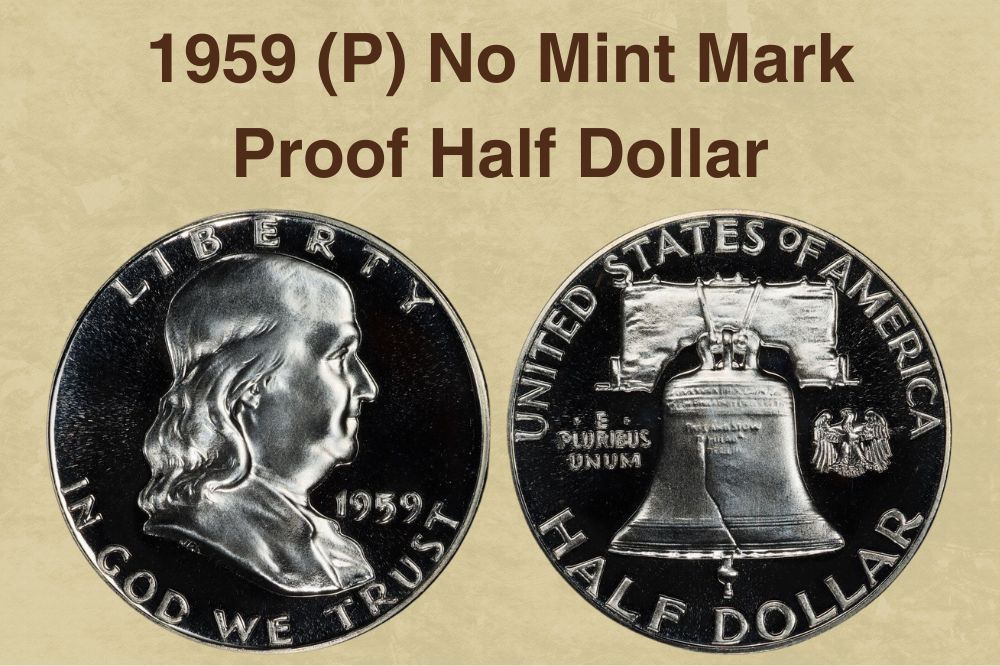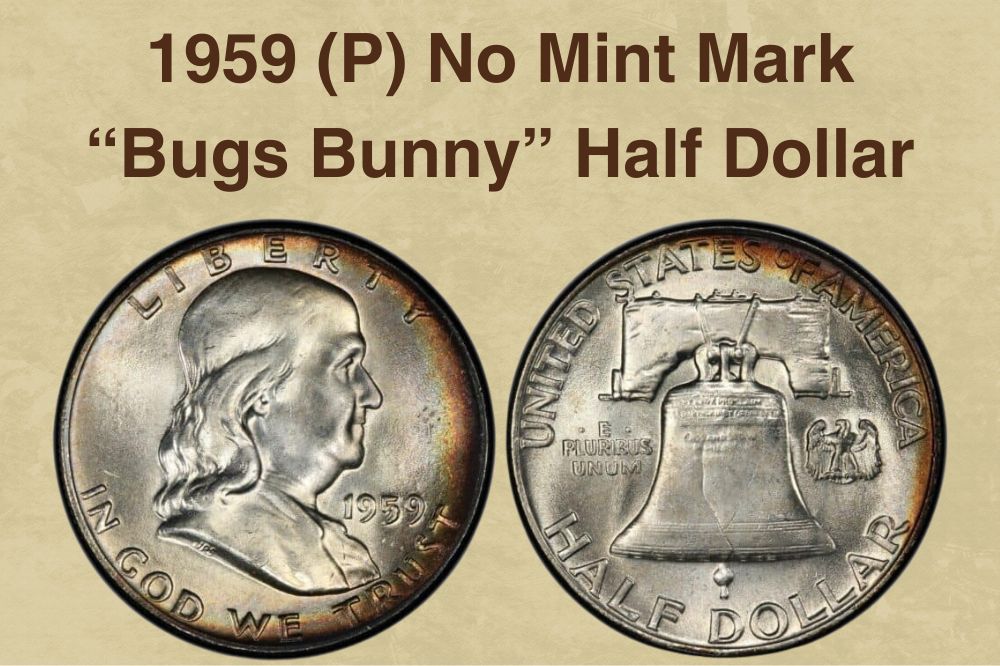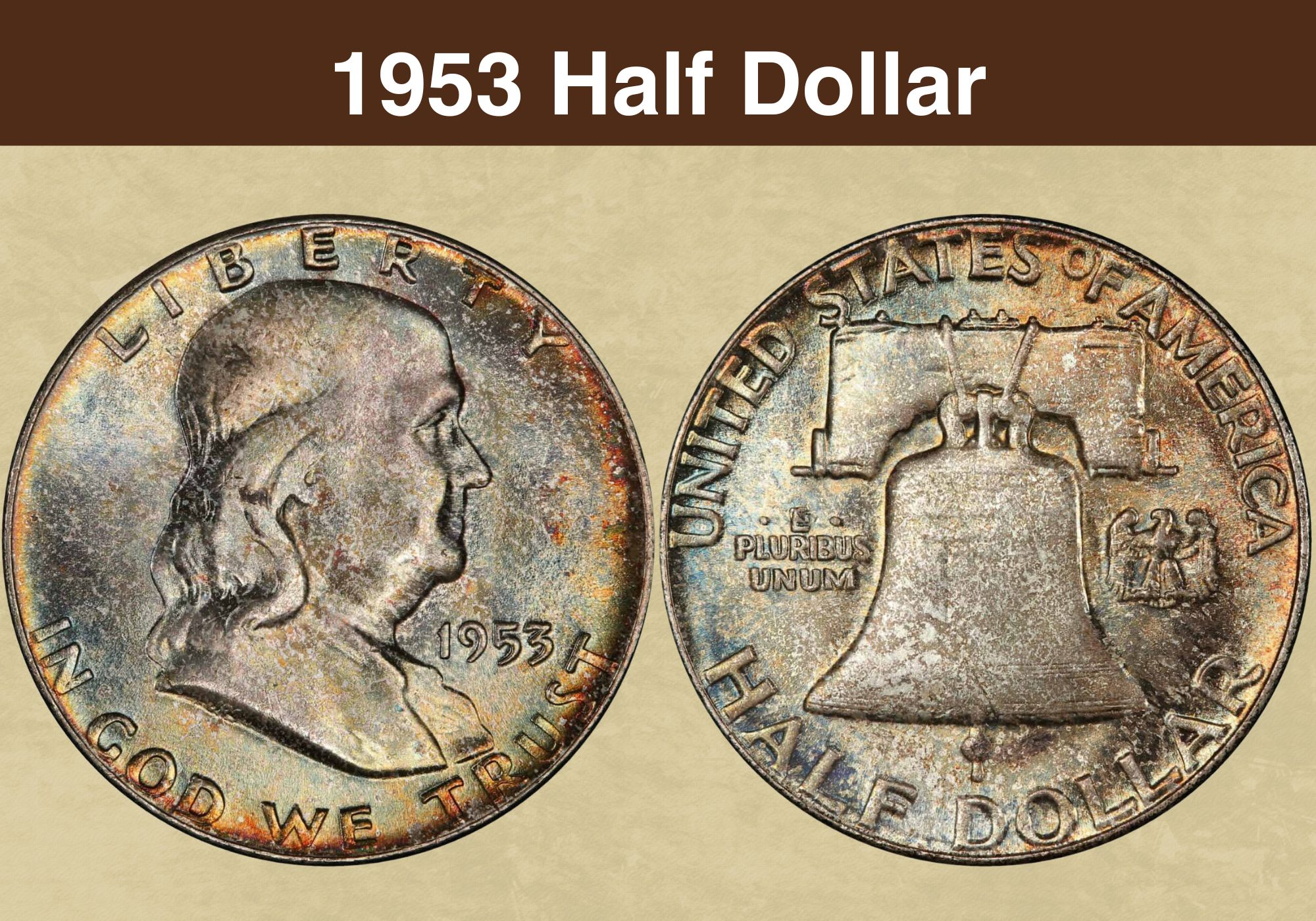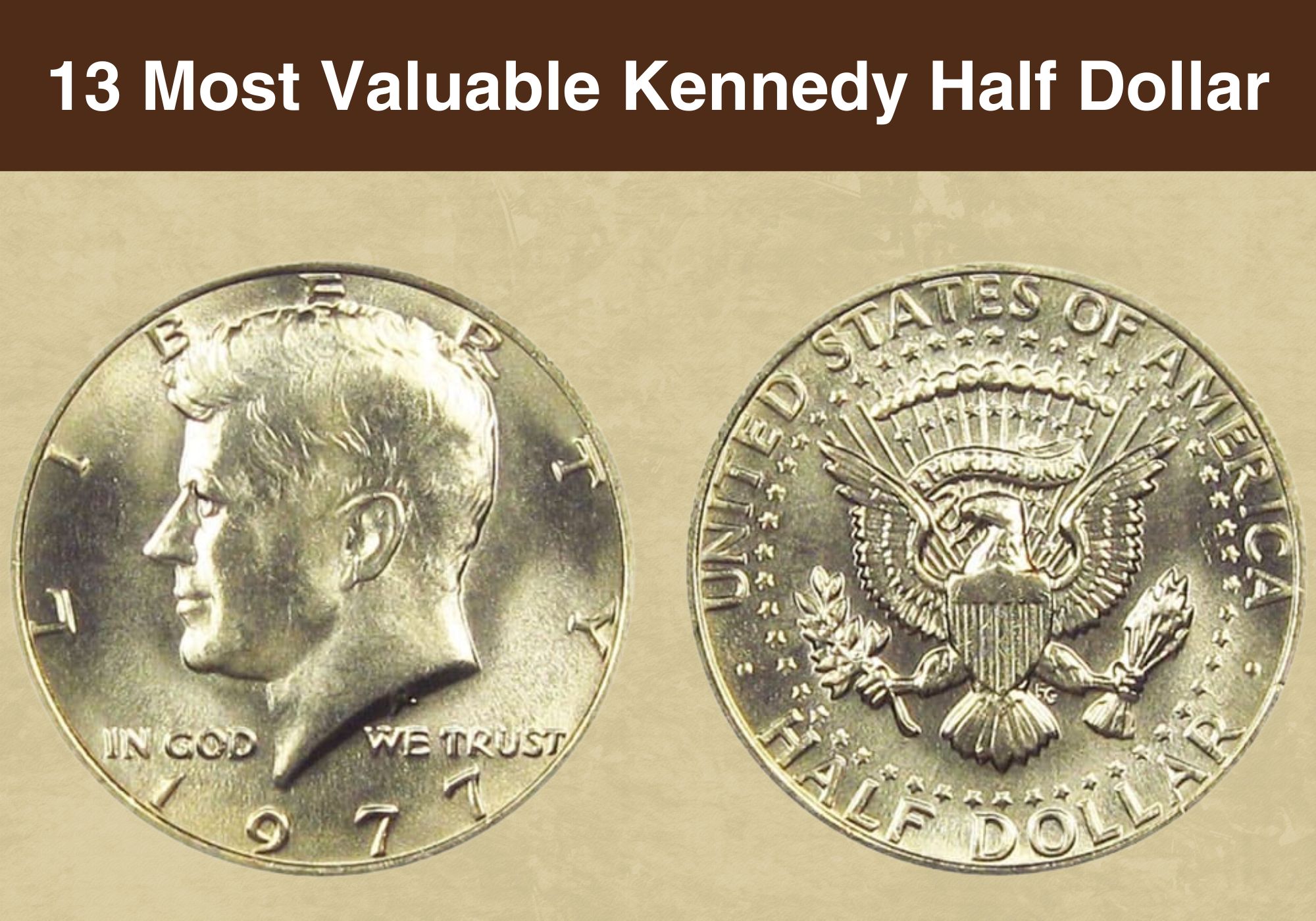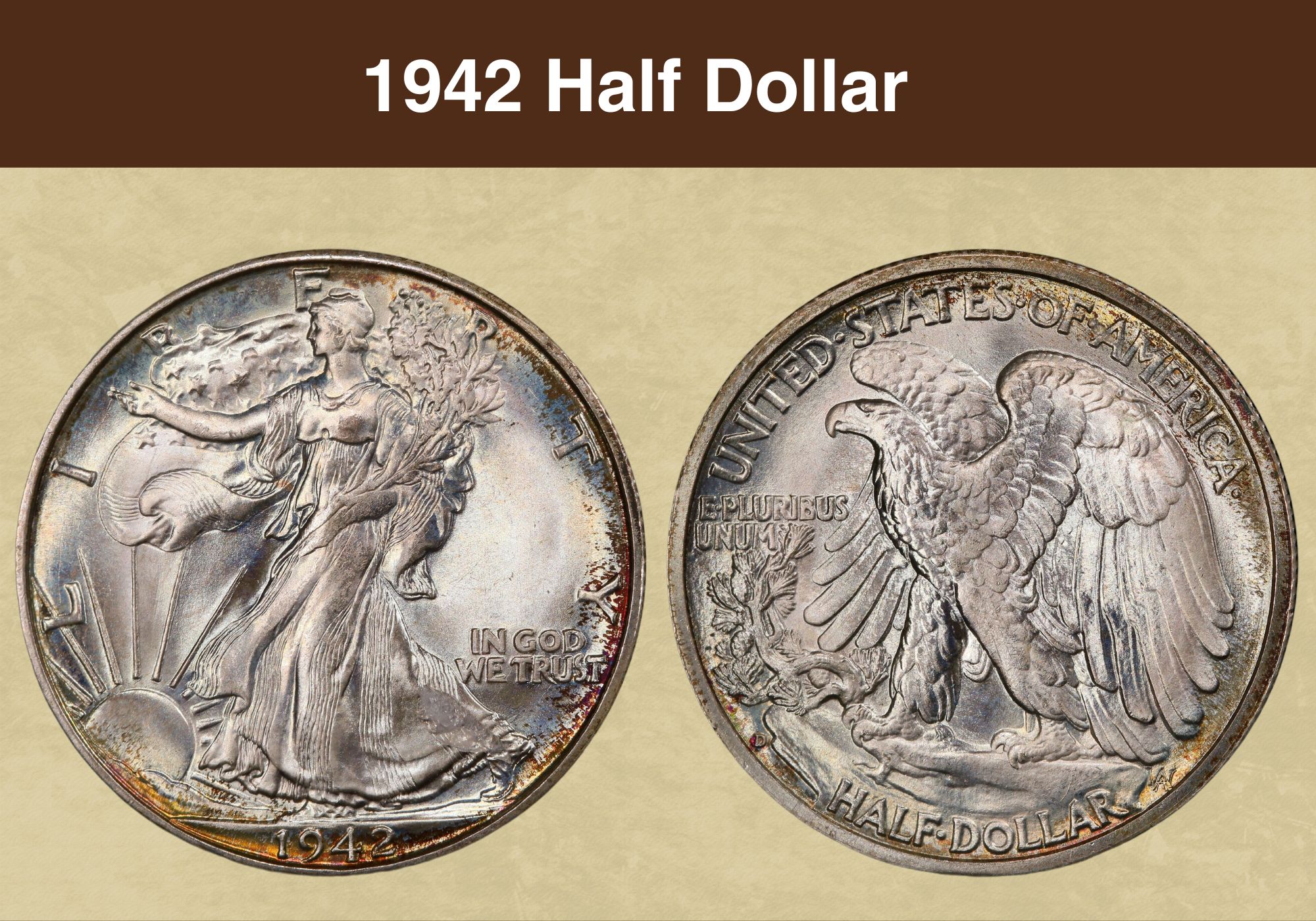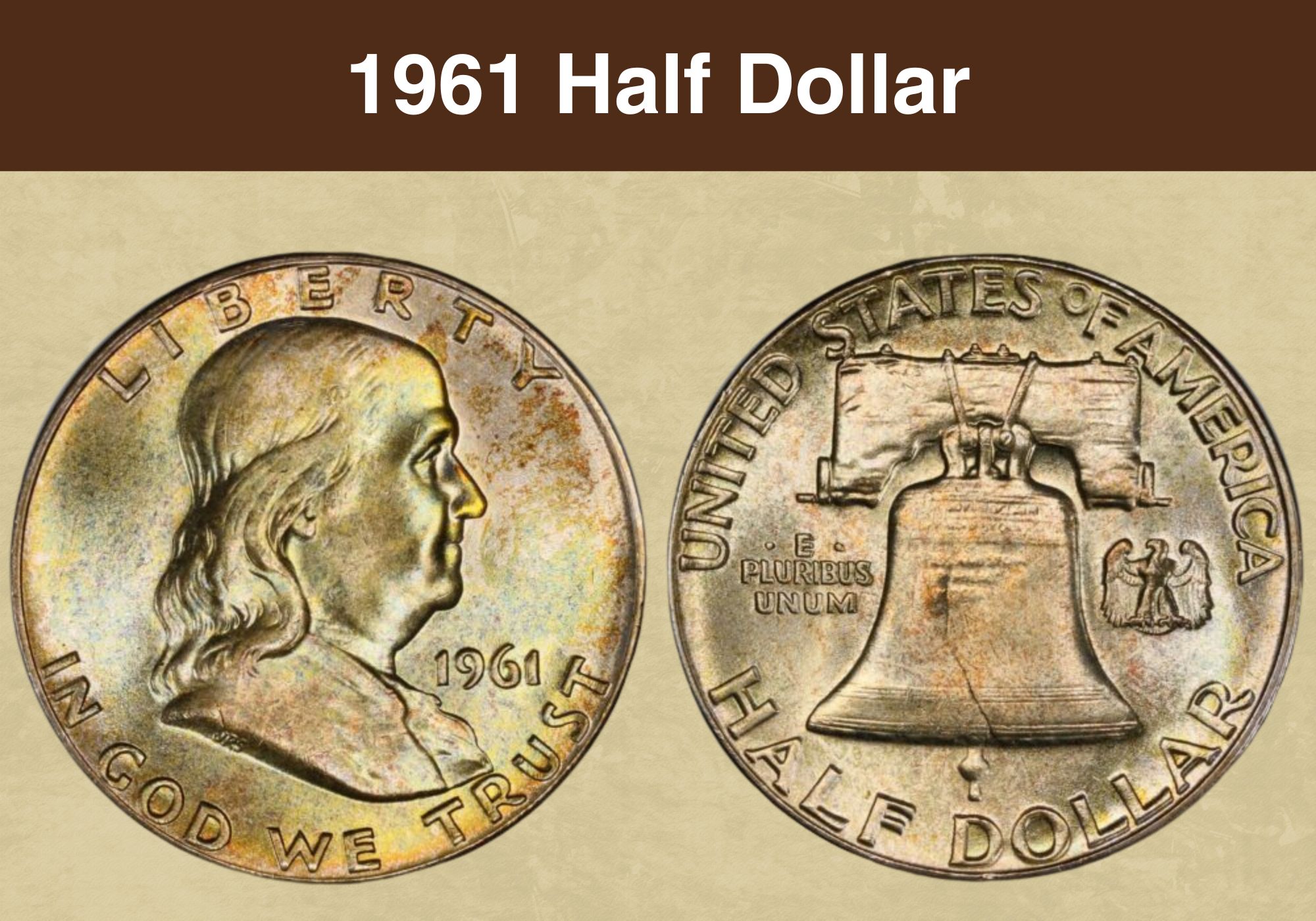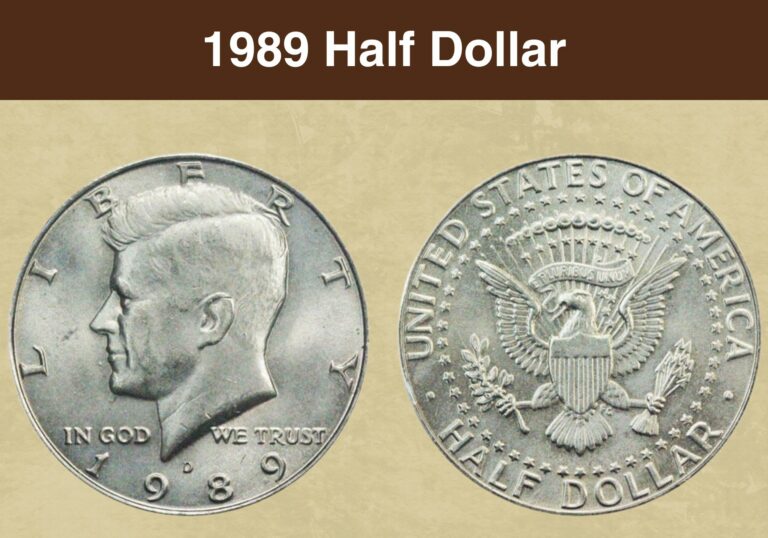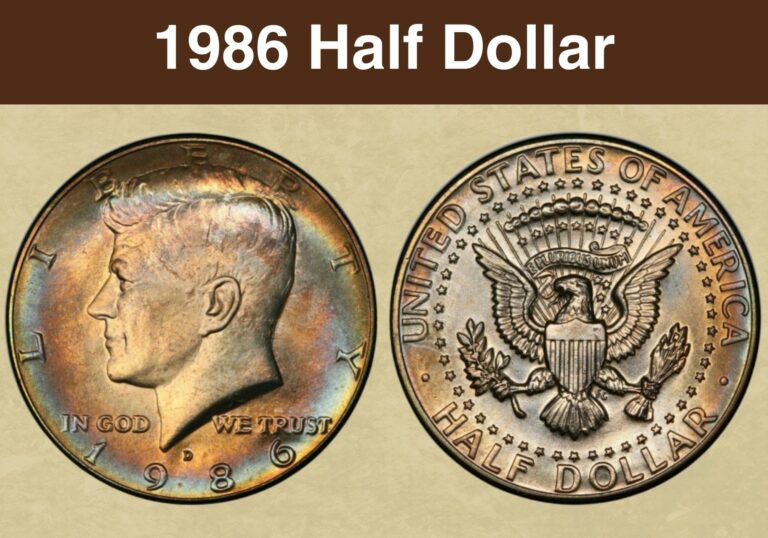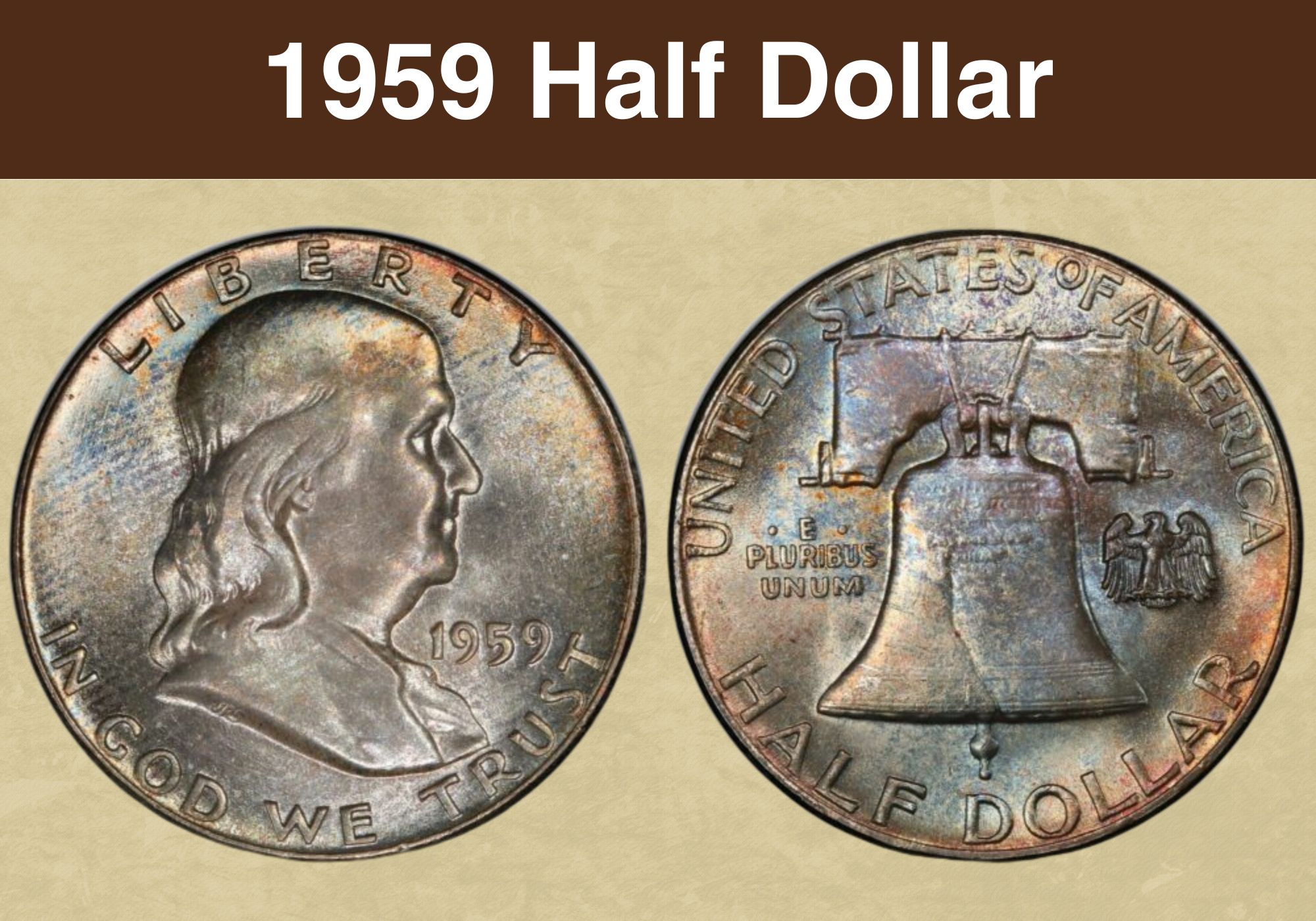
Coin Value Contents Table
- 1959 Half Dollar Value Chart
- History of the 1959 Half Dollar
- Features of the 1959 Half Dollar
- 1959 Franklin Half Dollar Grading
- 1959 Half Dollar Value Guides
- 1959 No Mint Mark Half Dollar Value
- 1959 D Half Dollar Value
- 1959 (P) No Mint Mark Proof Half Dollar Value
- Rare 1959 Half Dollars Errors List
- Where to Sell Your 1959 Half Dollar ?
- FAQs
The half dollar coin minted in 1959 is known as a Franklin half dollar. And if you’re interested in finding out more about it, you’ve come to the right place!
We have all the information you need on the 1959 half dollar value. We’ll look at how coin condition affects price. And we’ll check out some of the unusual error coins that escaped the Mint’s quality control processes.
So if you’re ready to find out more, let’s get started!
1959 Half Dollar Value Chart |
||||
| Mint Mark | XF45 | MS60 | MS65 | MS67 |
| 1959 No Mint Mark Half Dollar Value | $15 | $20
Full bell line: $22 |
$60
Full bell line: $115 |
$2,000
Full bell line: $25,000 |
| 1959 D Half Dollar Value | $15 | $20
Full bell line: $20 |
$65
Full bell line: $100 |
Full bell line: $7,500 |
|
|
PR60 | PR65 | PR67 | PR69 |
| 1959 No Mint Mark Proof Half Dollar Value | $17
Cameo: $18 |
$36
Cameo: $165 Deep cameo: $3,750 |
$62
Cameo: $775 Deep cameo: $15,000 |
$750
Cameo: $12,500 Deep cameo: $50,000 |
History of the 1959 Half Dollar
The half dollar struck in 1959 continued a series that had begun eleven years earlier. It bore the image of Benjamin Franklin on the obverse, giving it its nickname of the Franklin half dollar.
It came about because the Mint Director at the time, Nellie Tayloe Ross, was a great admirer of the Founding Father.
Franklin himself had opposed the idea of putting real people on the nation’s coins. But in an interview, Ross said she believed this was because the practice had been associated with monarchies in his lifetime. By 1948, the USA had already honored several former presidents on its coinage.
The design of the coin was begun by the Mint’s Chief Engraver, John Sinnock. But he died before it was completed. The work was completed by his successor in the role, Gilroy Roberts.
When the coin was issued, it was Sinnock’s initials – JRS – that appeared on the cut-off of the portrait. At the time, this gave rise to the conspiracy theory that the coin honored Russian president Josef Stalin. Stalin had no middle name, and the Mint duly ignored the nonsense.
By the time the Franklin half dollar was released, there was already a huge number of Walking Liberty half dollars in circulation. As a result, early mintages were low. It was not until 1957, with the economy growing, that larger quantities of the new coins were produced.
The 1959 half dollar was produced at Denver and Philadelphia, with the latter facility producing both business strikes and proofs. The San Francisco Mint facility had closed in 1955 and did not reopen until 1965.
The assassination of President John F. Kennedy in 1963 signaled the end for the Franklin half dollar. Congress rapidly authorized the production of a new half dollar to honor the fallen President. The first Kennedy half dollars were issued in 1964.
Also read: 13 Most Valuable Franklin Half Dollars Worth Money
Features of the 1959 Half Dollar
The Obverse of the 1959 Half Dollar
The Franklin half dollar gets its name from the portrait of Benjamin Franklin on its obverse. It was the work of John Sinnock, and shows the head and shoulders of the Founding Father in profile. Franklin faces to the right as the coin is viewed.
One variation of the design is known as the “Bugs Bunny”. This was caused by a clash between the obverse and reverse dies. The tip of the eagle’s wing from the reverse could be seen on the obverse. And for some collectors, its position gave Franklin the appearance of having buck teeth.
The word “LIBERTY” arches above the portrait, running parallel to the upper edge of the coin. At the bottom, it’s mirrored by the motto “IN GOD WE TRUST”. And to the right of Franklin, starting just below his chin, is the date.
The Reverse of the 1959 Half Dollar
The reverse of the 1959 half dollar shows the Liberty Bell. To the right is a small eagle in heraldic pose.
The eagle was an afterthought, added to comply with the requirements of the Coinage Act of 1873. This required the bird, national emblem of the USA, to be added to all denominations above a dime.
The design was begun by John Sinnock, but he died before completing it. It was finished by Gilroy Roberts, his successor as Chief Engraver at the Mint.
The design was submitted to the Commission for Fine Arts, but they refused to approve it. They felt that depicting the crack in the Liberty Bill would lead to unseemly puns. And the eagle, they considered, was too small to be worth including.
The Commission suggested a design competition to come up with an alternative. But the Treasury Secretary, John W. Snyder, decided to press on regardless, perhaps because he did not want to be seen as dishonoring Sinnock’s memory.
At the top of the coin, the words “UNITED STATES OF AMERICA” curve along the upper edge. The “O” is smaller than the rest of the legend. (This gave rise to the rumor that it was an error and that the coins would be recalled.)
If your half dollar was struck in Denver, it will have a mint mark of a small “D”. Look for it below the “E” of “STATES”.
To the left of the bell is the Latin motto “E PLURIBUS UNUM”. This means “From the many, one”, and refers to the creation of the USA as a union of states.
The denomination curves along the lower coin edge.
Other Features of the 1959 Half Dollar
The Franklin half dollar measures 30 millimeters in diameter and weighs a hefty 12.5 grams.
It’s made of 90 per cent silver and 10 per cent copper. And if you turn it on its edge, you’ll see a series of parallel lines running at right angles to the coin faces.
These are known as “reeds”, and they were first introduced to coins in the eighteenth century. At that time, most coins were made of precious metal. And unscrupulous traders could devalue them by shaving slivers of metal from the edge, a practice known as “coin clipping”.
The reeded edge was designed to put a stop to this. The pattern meant that it was possible for anyone receiving a coin to see at a glance if it had been tampered with.
The Franklin half dollar is divided into two main categories, depending on the quality of the strike. These are standard half dollars and those known as “full bell line”, or FBL.
The latter show full separation of the lines at the bottom of the Liberty Bell on the reverse. Those lines must also not have any marks or nicks.
This YouTube video from CoinWeek shows the Franklin dollar in detail, and talks through what’s required for an FBL designation.
1959 Franklin Half Dollar Grading
| # | Grade |
|---|---|
| 1 | Basal State-1 |
| 2 | Fair |
| 3 | Very Fair |
| 4, 5, 6 | Good |
| 7, 8, 10 | Very Good |
| 12, 15 | Fine |
| 20, 30 | Very Fine |
| 40 | Extremely Fine |
| 50 | About Uncirculated |
| 60 | Mint State |
| 65 | Mint State |
| 70 | Mint State |
Please check our grading guides to know your coin scale, It’s the necessary step to know the exact value of your coin.
Check out now: How to Grade Franklin Half Dollar?
1959 Half Dollar Value Guides
1959 No Mint Mark Half Dollar Value
Both the silver content and collectability of 1959 half dollars means they’re worth more than their face value in any condition.
Business strike Philadelphia 1959 half dollars – those without the Denver mint mark or the mirror-like surfaces of proofs – originally numbered 6.2 million. Today, it’s estimated that around one in ten of those survive at all grades.
Examples in circulated condition are worth between around $15 and $18. A standard half dollar graded MS60 (the coin grading scale runs from 1 to 70) is worth around $20. And a coin at the same grade with the FBL designation is worth a couple of dollars more.
As coin condition improves, the premium for FBL half dollars increases. At MS65 – the lowest grade at which a coin is termed a “gem” – the value of a standard half dollar is $60. But if it has full bell lines, that increases to $115.
The finest known examples of 1959 no mint mark half dollars are graded MS67. A standard half dollar at that level is valued by the independent coin grading agency, the PCGS, at $2,000.
Five FBL half dollars have been certified at MS67 too. And each one of these is valued at a staggering $25,000.
1959 D Half Dollar Value
The Denver Mint facility struck some 13 million half dollars in 1959. At most grades, values are similar to the no mint mark equivalents. Circulated coins are worth between $15 and $18, while an uncirculated example at MS60 is worth a couple of dollars more.
The FBL designation adds a small premium at MS60, with a value of around $20. At MS65, there’s a greater disparity. While a standard half dollar is worth $70, an FBL example is valued at $100.
The cream of the crop are three half dollars with full bell lines graded MS67+ by the PCGS. Those are each worth an impressive $27,500.
1959 (P) No Mint Mark Proof Half Dollar Value
In addition to producing business strike half dollars for circulation, the Philadelphia Mint facility also struck proof coins. These were made using special dies and highly polished planchets. The mintage was just over 1.1 million, and the coins were aimed mainly at collectors.
Proofs are divided into three categories: standard, cameos, and deep cameos. To be awarded cameo status, a coin must have a clear contrast between frosting on the raised parts of the design, and mirror-like flat areas. With deep cameos, that contrast is especially strong.
Both cameos and deep cameos are relatively rare amongst 1959 proof half dollars – and that’s reflected in their values.
A standard proof graded PR65 is valued by the PCGS at around $36. But if it’s a cameo, that value increases to $165. And a deep cameo at the same grade is worth around $3,750.
The finest known examples are graded a near-perfect PR69. A standard proof half dollar at that grade will set you back around $750. For a cameo, you’ll need to part with a five-figure sum – the PCGS value is $12,500.
And the crème de la crème, a deep cameo graded PR69, is valued at no less than $50,000.
Also read: 13 Most Valuable Kennedy Half Dollar Worth Money
Rare 1959 Half Dollars Errors List
1959 (P) No Mint Mark “Bugs Bunny” Half Dollar
The variant known as the “Bugs Bunny” half dollar was the result of clashing dies at the Philadelphia Mint facility. Part of the reverse design – the wing tip of the eagle – could be seen on the obverse.
It’s a very small error – you’ll need a microscope or loupe to spot it. But its position, just next to Franklin’s mouth, led some observers to liken it to buck teeth – hence the nickname.
The value of one of these error coins depends on its condition. A circulated coin graded F12 (the letter stands for “fine”) will be worth around $15. That rises to $20 at VF20 (“very fine”), $30 at XF45 (“extremely fine”), and $40 at AU50 (“about uncirculated”).
Mint state examples start at $50 for a standard MS60, while gems start at $200. Coins with full bell lines carry a premium, with values starting at $75 at MS62, and peaking at $4,500 at MS66+.
This YouTube video from PCGScoin looks in detail at this variety.
1959 (P) No Mint Mark “Goiter” Half Dollar
Another of the errors that took place at the Philadelphia Mint gave Benjamin Franklin a somewhat unflattering appearance. In this case, a die break resulted in a double line at Franklin’s throat, giving the error the nickname of the “Goiter half dollar”.
As with the Bugs Bunny variant, condition is key to value. But even a standard half dollar graded XF40 with this error will likely set you back more than $100.
In mint state, values start at $135 for a standard MS60. Full bell line examples are available from MS63 ($210) to three coins graded MS66. No sales information is available for the latter, and the PCGS doesn’t estimate their value. But a point lower, and the value is around $650.
Also read: 11 Most Valuable Half Dollars In Circulation
Where to Sell Your 1959 Half Dollar ?
Now that you know the value of your coins, do you know where to sell those coins online easily? Don’t worry, I’ve compiled a list of these sites, including their introduction, pros, and cons.
Check out now: Best Places To Sell Coins Online (Pros & Cons)
FAQs
How much silver is in a 1959 half dollar?
The 1959 half dollar is made of 90 per cent silver and weighs 12.5 grams. That gives it a silver weight of 11.25 grams.
The rest of the weight comes from the coin’s copper content.
Where is the mint mark on a 1959 half dollar?
If your 1959 half dollar was struck in Philadelphia, it won’t have a mint mark. But if it was struck in Denver, there’ll be a small “D” on the reverse (the “tails” side). Look for it above the bell and below the “E” of “STATES”.

